BlueScope Corporate: Major Export Report for International Business
VerifiedAdded on 2022/09/23
|18
|4506
|29
Report
AI Summary
This report provides a detailed analysis of BlueScope Corporate's export strategy. It begins with an introduction outlining the company's objectives in venturing into overseas markets, emphasizing the goal to increase sales and diversify the customer base. The report covers the company's history, domestic business overview, and financial resources, including the marketing budget, cash flow management, and sustainability of the export budget. It delves into market selection strategies, discussing target markets, market positioning, competitor analysis, distribution methods, and sales goals. The product section explores exported products, necessary modifications, and production capacity. Finally, the report examines pricing, market-entry, promotional, action plan, and management strategies. The report highlights key aspects such as financial resources, staff, market selection, product considerations, and strategic planning. This report examines the company's plans to expand its international presence, increase revenue, and compete effectively in the steel industry.
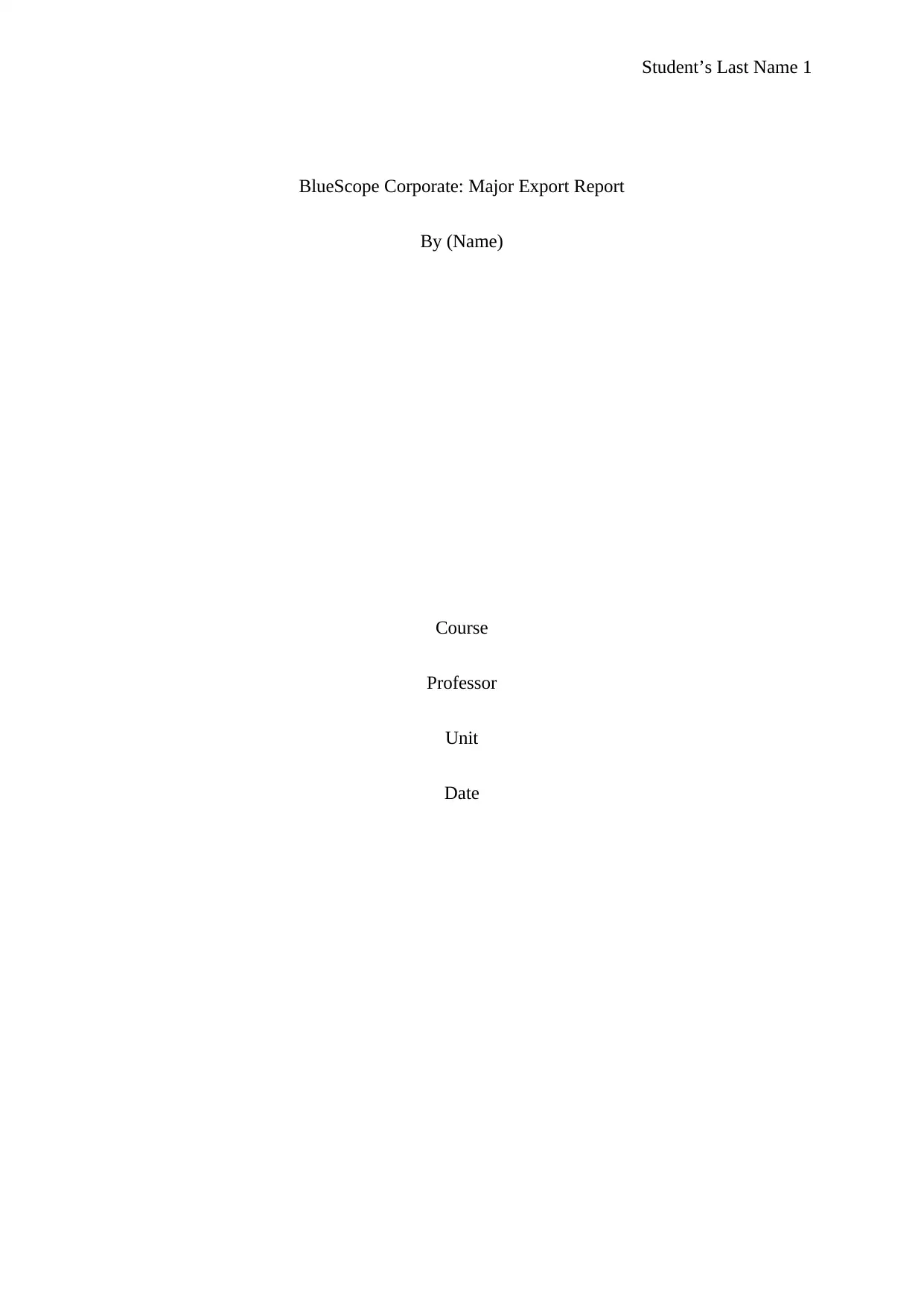
Student’s Last Name 1
BlueScope Corporate: Major Export Report
By (Name)
Course
Professor
Unit
Date
BlueScope Corporate: Major Export Report
By (Name)
Course
Professor
Unit
Date
Paraphrase This Document
Need a fresh take? Get an instant paraphrase of this document with our AI Paraphraser
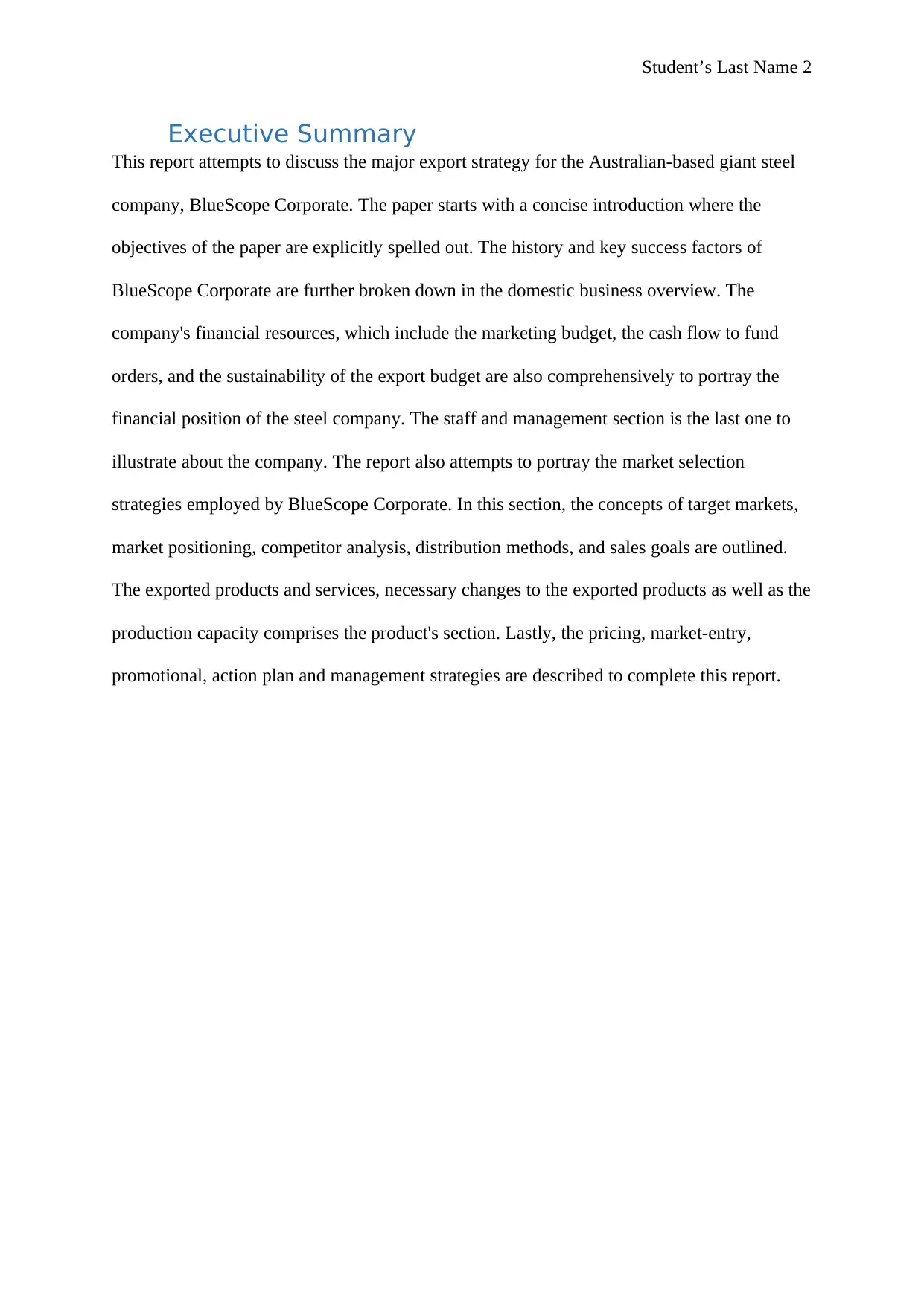
Student’s Last Name 2
Executive Summary
This report attempts to discuss the major export strategy for the Australian-based giant steel
company, BlueScope Corporate. The paper starts with a concise introduction where the
objectives of the paper are explicitly spelled out. The history and key success factors of
BlueScope Corporate are further broken down in the domestic business overview. The
company's financial resources, which include the marketing budget, the cash flow to fund
orders, and the sustainability of the export budget are also comprehensively to portray the
financial position of the steel company. The staff and management section is the last one to
illustrate about the company. The report also attempts to portray the market selection
strategies employed by BlueScope Corporate. In this section, the concepts of target markets,
market positioning, competitor analysis, distribution methods, and sales goals are outlined.
The exported products and services, necessary changes to the exported products as well as the
production capacity comprises the product's section. Lastly, the pricing, market-entry,
promotional, action plan and management strategies are described to complete this report.
Executive Summary
This report attempts to discuss the major export strategy for the Australian-based giant steel
company, BlueScope Corporate. The paper starts with a concise introduction where the
objectives of the paper are explicitly spelled out. The history and key success factors of
BlueScope Corporate are further broken down in the domestic business overview. The
company's financial resources, which include the marketing budget, the cash flow to fund
orders, and the sustainability of the export budget are also comprehensively to portray the
financial position of the steel company. The staff and management section is the last one to
illustrate about the company. The report also attempts to portray the market selection
strategies employed by BlueScope Corporate. In this section, the concepts of target markets,
market positioning, competitor analysis, distribution methods, and sales goals are outlined.
The exported products and services, necessary changes to the exported products as well as the
production capacity comprises the product's section. Lastly, the pricing, market-entry,
promotional, action plan and management strategies are described to complete this report.
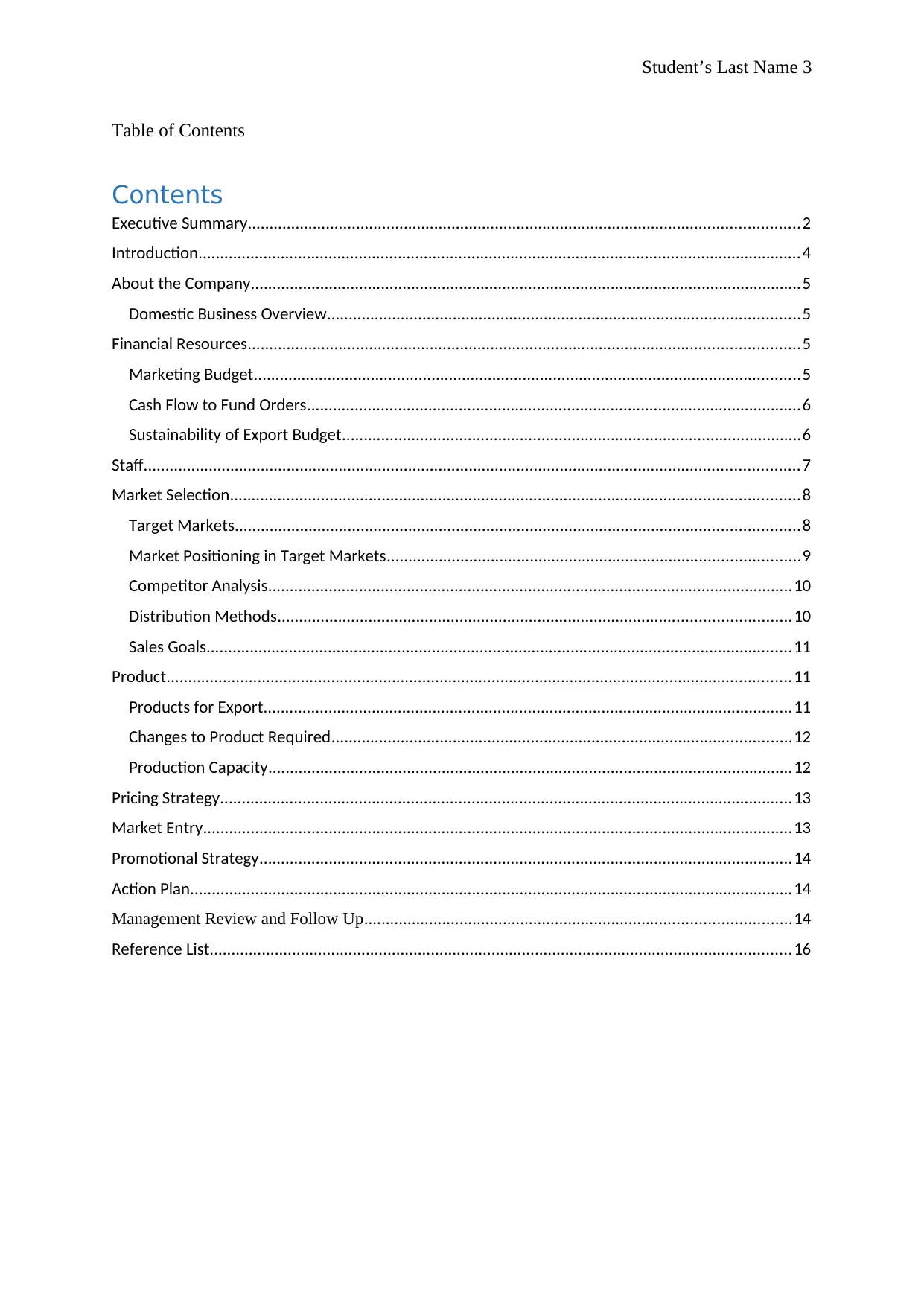
Student’s Last Name 3
Table of Contents
Contents
Executive Summary...............................................................................................................................2
Introduction...........................................................................................................................................4
About the Company...............................................................................................................................5
Domestic Business Overview.............................................................................................................5
Financial Resources...............................................................................................................................5
Marketing Budget..............................................................................................................................5
Cash Flow to Fund Orders..................................................................................................................6
Sustainability of Export Budget..........................................................................................................6
Staff.......................................................................................................................................................7
Market Selection...................................................................................................................................8
Target Markets..................................................................................................................................8
Market Positioning in Target Markets...............................................................................................9
Competitor Analysis.........................................................................................................................10
Distribution Methods......................................................................................................................10
Sales Goals.......................................................................................................................................11
Product................................................................................................................................................11
Products for Export..........................................................................................................................11
Changes to Product Required..........................................................................................................12
Production Capacity.........................................................................................................................12
Pricing Strategy....................................................................................................................................13
Market Entry........................................................................................................................................13
Promotional Strategy...........................................................................................................................14
Action Plan...........................................................................................................................................14
Management Review and Follow Up..................................................................................................14
Reference List......................................................................................................................................16
Table of Contents
Contents
Executive Summary...............................................................................................................................2
Introduction...........................................................................................................................................4
About the Company...............................................................................................................................5
Domestic Business Overview.............................................................................................................5
Financial Resources...............................................................................................................................5
Marketing Budget..............................................................................................................................5
Cash Flow to Fund Orders..................................................................................................................6
Sustainability of Export Budget..........................................................................................................6
Staff.......................................................................................................................................................7
Market Selection...................................................................................................................................8
Target Markets..................................................................................................................................8
Market Positioning in Target Markets...............................................................................................9
Competitor Analysis.........................................................................................................................10
Distribution Methods......................................................................................................................10
Sales Goals.......................................................................................................................................11
Product................................................................................................................................................11
Products for Export..........................................................................................................................11
Changes to Product Required..........................................................................................................12
Production Capacity.........................................................................................................................12
Pricing Strategy....................................................................................................................................13
Market Entry........................................................................................................................................13
Promotional Strategy...........................................................................................................................14
Action Plan...........................................................................................................................................14
Management Review and Follow Up..................................................................................................14
Reference List......................................................................................................................................16
⊘ This is a preview!⊘
Do you want full access?
Subscribe today to unlock all pages.

Trusted by 1+ million students worldwide
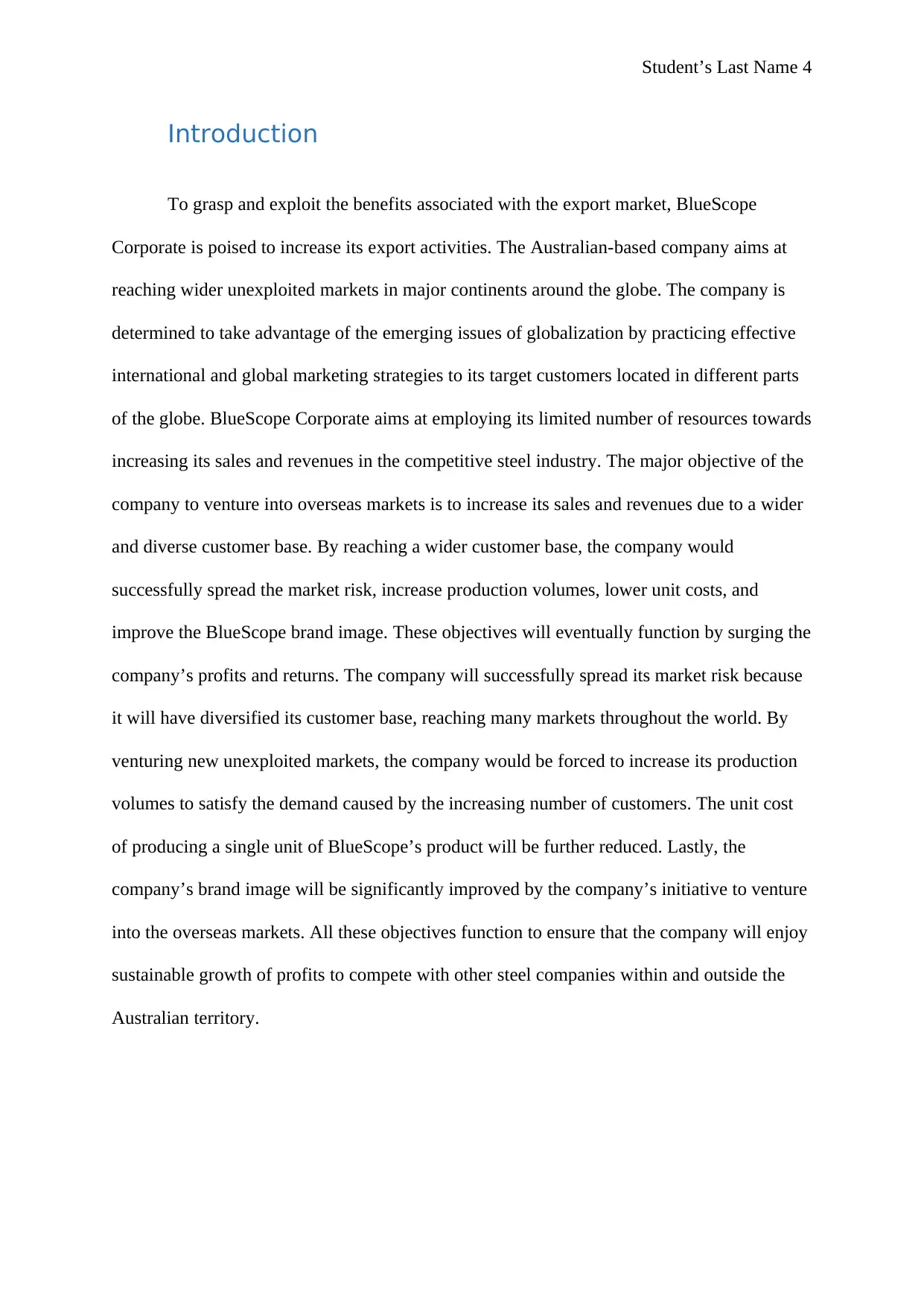
Student’s Last Name 4
Introduction
To grasp and exploit the benefits associated with the export market, BlueScope
Corporate is poised to increase its export activities. The Australian-based company aims at
reaching wider unexploited markets in major continents around the globe. The company is
determined to take advantage of the emerging issues of globalization by practicing effective
international and global marketing strategies to its target customers located in different parts
of the globe. BlueScope Corporate aims at employing its limited number of resources towards
increasing its sales and revenues in the competitive steel industry. The major objective of the
company to venture into overseas markets is to increase its sales and revenues due to a wider
and diverse customer base. By reaching a wider customer base, the company would
successfully spread the market risk, increase production volumes, lower unit costs, and
improve the BlueScope brand image. These objectives will eventually function by surging the
company’s profits and returns. The company will successfully spread its market risk because
it will have diversified its customer base, reaching many markets throughout the world. By
venturing new unexploited markets, the company would be forced to increase its production
volumes to satisfy the demand caused by the increasing number of customers. The unit cost
of producing a single unit of BlueScope’s product will be further reduced. Lastly, the
company’s brand image will be significantly improved by the company’s initiative to venture
into the overseas markets. All these objectives function to ensure that the company will enjoy
sustainable growth of profits to compete with other steel companies within and outside the
Australian territory.
Introduction
To grasp and exploit the benefits associated with the export market, BlueScope
Corporate is poised to increase its export activities. The Australian-based company aims at
reaching wider unexploited markets in major continents around the globe. The company is
determined to take advantage of the emerging issues of globalization by practicing effective
international and global marketing strategies to its target customers located in different parts
of the globe. BlueScope Corporate aims at employing its limited number of resources towards
increasing its sales and revenues in the competitive steel industry. The major objective of the
company to venture into overseas markets is to increase its sales and revenues due to a wider
and diverse customer base. By reaching a wider customer base, the company would
successfully spread the market risk, increase production volumes, lower unit costs, and
improve the BlueScope brand image. These objectives will eventually function by surging the
company’s profits and returns. The company will successfully spread its market risk because
it will have diversified its customer base, reaching many markets throughout the world. By
venturing new unexploited markets, the company would be forced to increase its production
volumes to satisfy the demand caused by the increasing number of customers. The unit cost
of producing a single unit of BlueScope’s product will be further reduced. Lastly, the
company’s brand image will be significantly improved by the company’s initiative to venture
into the overseas markets. All these objectives function to ensure that the company will enjoy
sustainable growth of profits to compete with other steel companies within and outside the
Australian territory.
Paraphrase This Document
Need a fresh take? Get an instant paraphrase of this document with our AI Paraphraser
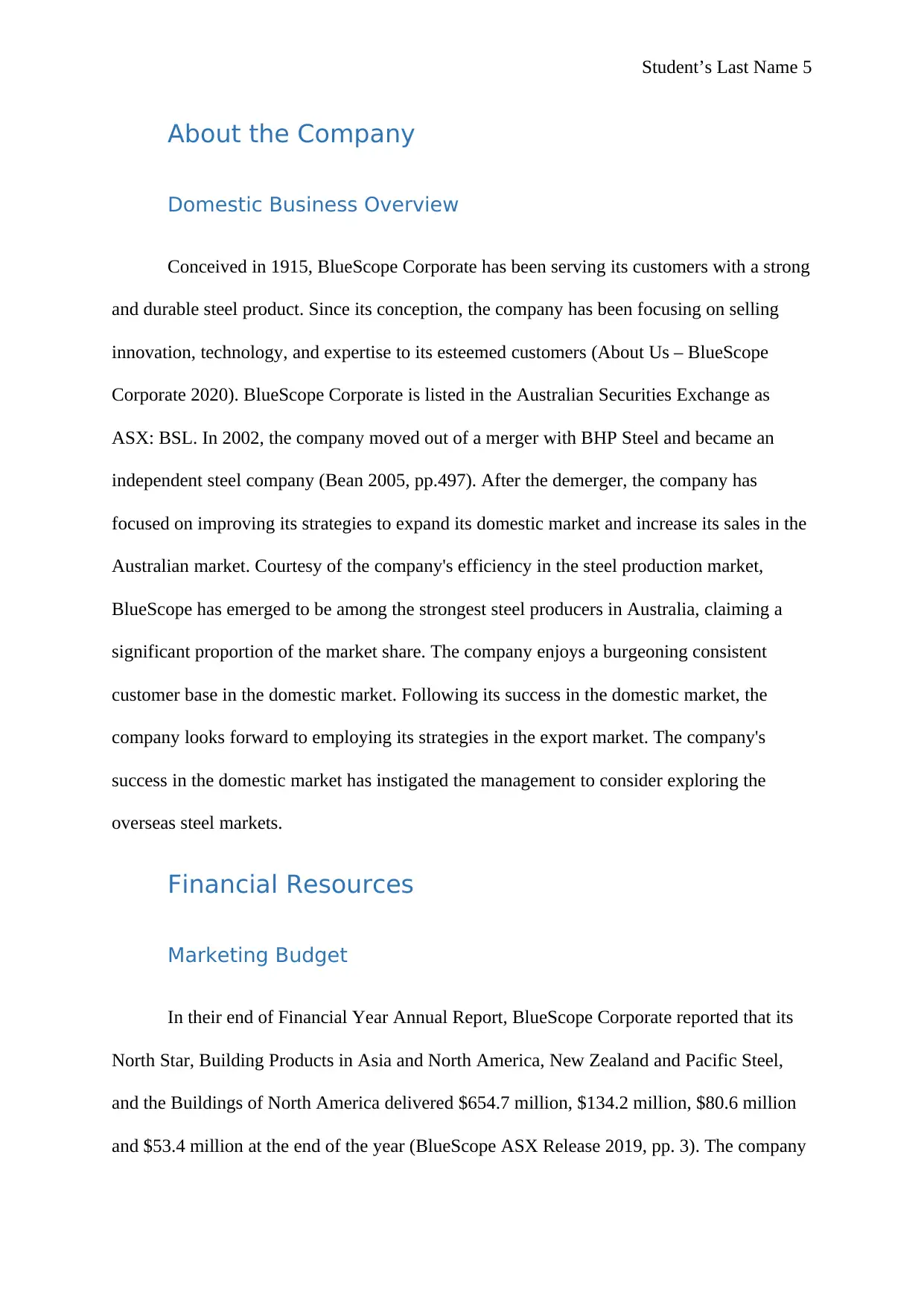
Student’s Last Name 5
About the Company
Domestic Business Overview
Conceived in 1915, BlueScope Corporate has been serving its customers with a strong
and durable steel product. Since its conception, the company has been focusing on selling
innovation, technology, and expertise to its esteemed customers (About Us – BlueScope
Corporate 2020). BlueScope Corporate is listed in the Australian Securities Exchange as
ASX: BSL. In 2002, the company moved out of a merger with BHP Steel and became an
independent steel company (Bean 2005, pp.497). After the demerger, the company has
focused on improving its strategies to expand its domestic market and increase its sales in the
Australian market. Courtesy of the company's efficiency in the steel production market,
BlueScope has emerged to be among the strongest steel producers in Australia, claiming a
significant proportion of the market share. The company enjoys a burgeoning consistent
customer base in the domestic market. Following its success in the domestic market, the
company looks forward to employing its strategies in the export market. The company's
success in the domestic market has instigated the management to consider exploring the
overseas steel markets.
Financial Resources
Marketing Budget
In their end of Financial Year Annual Report, BlueScope Corporate reported that its
North Star, Building Products in Asia and North America, New Zealand and Pacific Steel,
and the Buildings of North America delivered $654.7 million, $134.2 million, $80.6 million
and $53.4 million at the end of the year (BlueScope ASX Release 2019, pp. 3). The company
About the Company
Domestic Business Overview
Conceived in 1915, BlueScope Corporate has been serving its customers with a strong
and durable steel product. Since its conception, the company has been focusing on selling
innovation, technology, and expertise to its esteemed customers (About Us – BlueScope
Corporate 2020). BlueScope Corporate is listed in the Australian Securities Exchange as
ASX: BSL. In 2002, the company moved out of a merger with BHP Steel and became an
independent steel company (Bean 2005, pp.497). After the demerger, the company has
focused on improving its strategies to expand its domestic market and increase its sales in the
Australian market. Courtesy of the company's efficiency in the steel production market,
BlueScope has emerged to be among the strongest steel producers in Australia, claiming a
significant proportion of the market share. The company enjoys a burgeoning consistent
customer base in the domestic market. Following its success in the domestic market, the
company looks forward to employing its strategies in the export market. The company's
success in the domestic market has instigated the management to consider exploring the
overseas steel markets.
Financial Resources
Marketing Budget
In their end of Financial Year Annual Report, BlueScope Corporate reported that its
North Star, Building Products in Asia and North America, New Zealand and Pacific Steel,
and the Buildings of North America delivered $654.7 million, $134.2 million, $80.6 million
and $53.4 million at the end of the year (BlueScope ASX Release 2019, pp. 3). The company
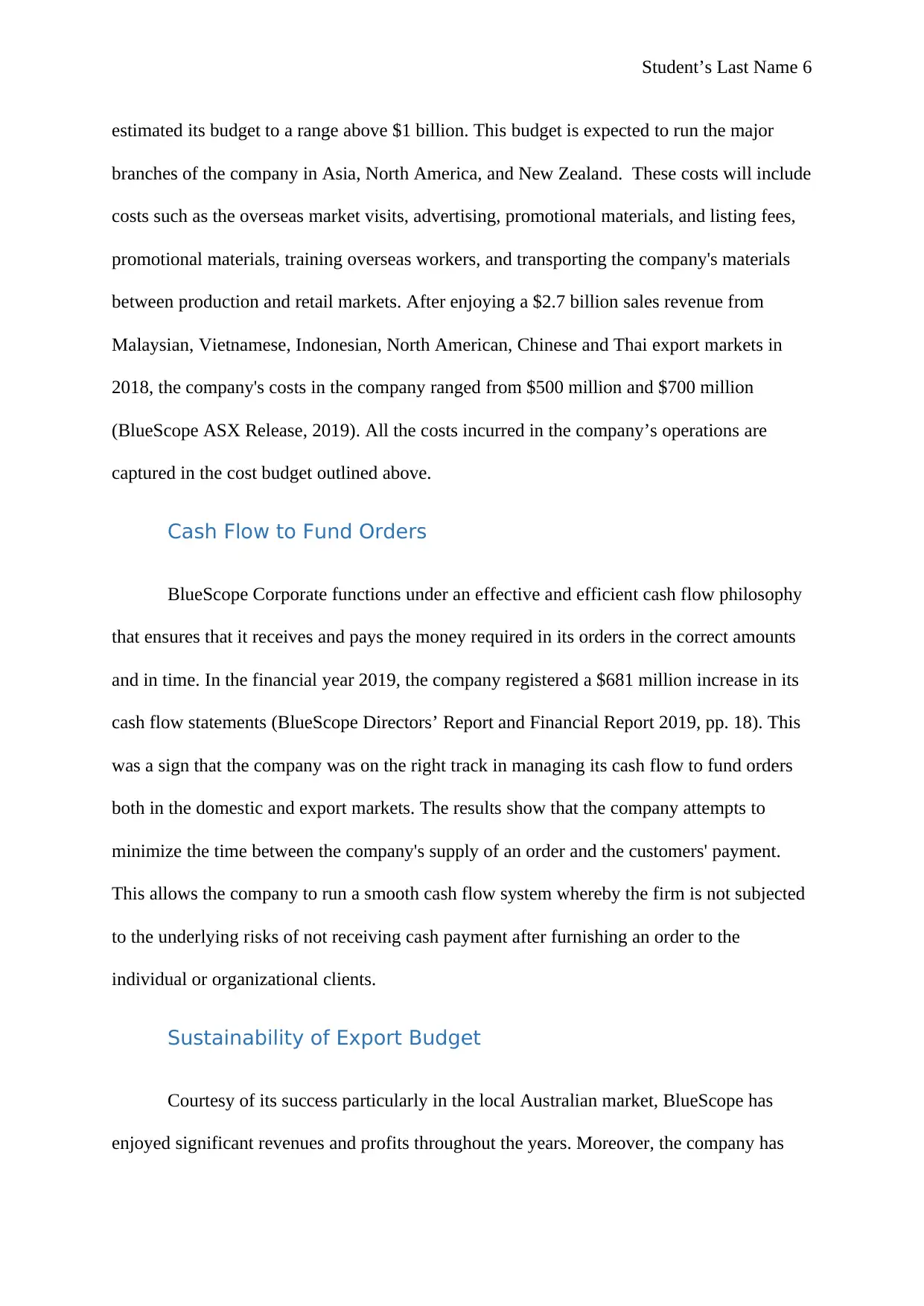
Student’s Last Name 6
estimated its budget to a range above $1 billion. This budget is expected to run the major
branches of the company in Asia, North America, and New Zealand. These costs will include
costs such as the overseas market visits, advertising, promotional materials, and listing fees,
promotional materials, training overseas workers, and transporting the company's materials
between production and retail markets. After enjoying a $2.7 billion sales revenue from
Malaysian, Vietnamese, Indonesian, North American, Chinese and Thai export markets in
2018, the company's costs in the company ranged from $500 million and $700 million
(BlueScope ASX Release, 2019). All the costs incurred in the company’s operations are
captured in the cost budget outlined above.
Cash Flow to Fund Orders
BlueScope Corporate functions under an effective and efficient cash flow philosophy
that ensures that it receives and pays the money required in its orders in the correct amounts
and in time. In the financial year 2019, the company registered a $681 million increase in its
cash flow statements (BlueScope Directors’ Report and Financial Report 2019, pp. 18). This
was a sign that the company was on the right track in managing its cash flow to fund orders
both in the domestic and export markets. The results show that the company attempts to
minimize the time between the company's supply of an order and the customers' payment.
This allows the company to run a smooth cash flow system whereby the firm is not subjected
to the underlying risks of not receiving cash payment after furnishing an order to the
individual or organizational clients.
Sustainability of Export Budget
Courtesy of its success particularly in the local Australian market, BlueScope has
enjoyed significant revenues and profits throughout the years. Moreover, the company has
estimated its budget to a range above $1 billion. This budget is expected to run the major
branches of the company in Asia, North America, and New Zealand. These costs will include
costs such as the overseas market visits, advertising, promotional materials, and listing fees,
promotional materials, training overseas workers, and transporting the company's materials
between production and retail markets. After enjoying a $2.7 billion sales revenue from
Malaysian, Vietnamese, Indonesian, North American, Chinese and Thai export markets in
2018, the company's costs in the company ranged from $500 million and $700 million
(BlueScope ASX Release, 2019). All the costs incurred in the company’s operations are
captured in the cost budget outlined above.
Cash Flow to Fund Orders
BlueScope Corporate functions under an effective and efficient cash flow philosophy
that ensures that it receives and pays the money required in its orders in the correct amounts
and in time. In the financial year 2019, the company registered a $681 million increase in its
cash flow statements (BlueScope Directors’ Report and Financial Report 2019, pp. 18). This
was a sign that the company was on the right track in managing its cash flow to fund orders
both in the domestic and export markets. The results show that the company attempts to
minimize the time between the company's supply of an order and the customers' payment.
This allows the company to run a smooth cash flow system whereby the firm is not subjected
to the underlying risks of not receiving cash payment after furnishing an order to the
individual or organizational clients.
Sustainability of Export Budget
Courtesy of its success particularly in the local Australian market, BlueScope has
enjoyed significant revenues and profits throughout the years. Moreover, the company has
⊘ This is a preview!⊘
Do you want full access?
Subscribe today to unlock all pages.

Trusted by 1+ million students worldwide
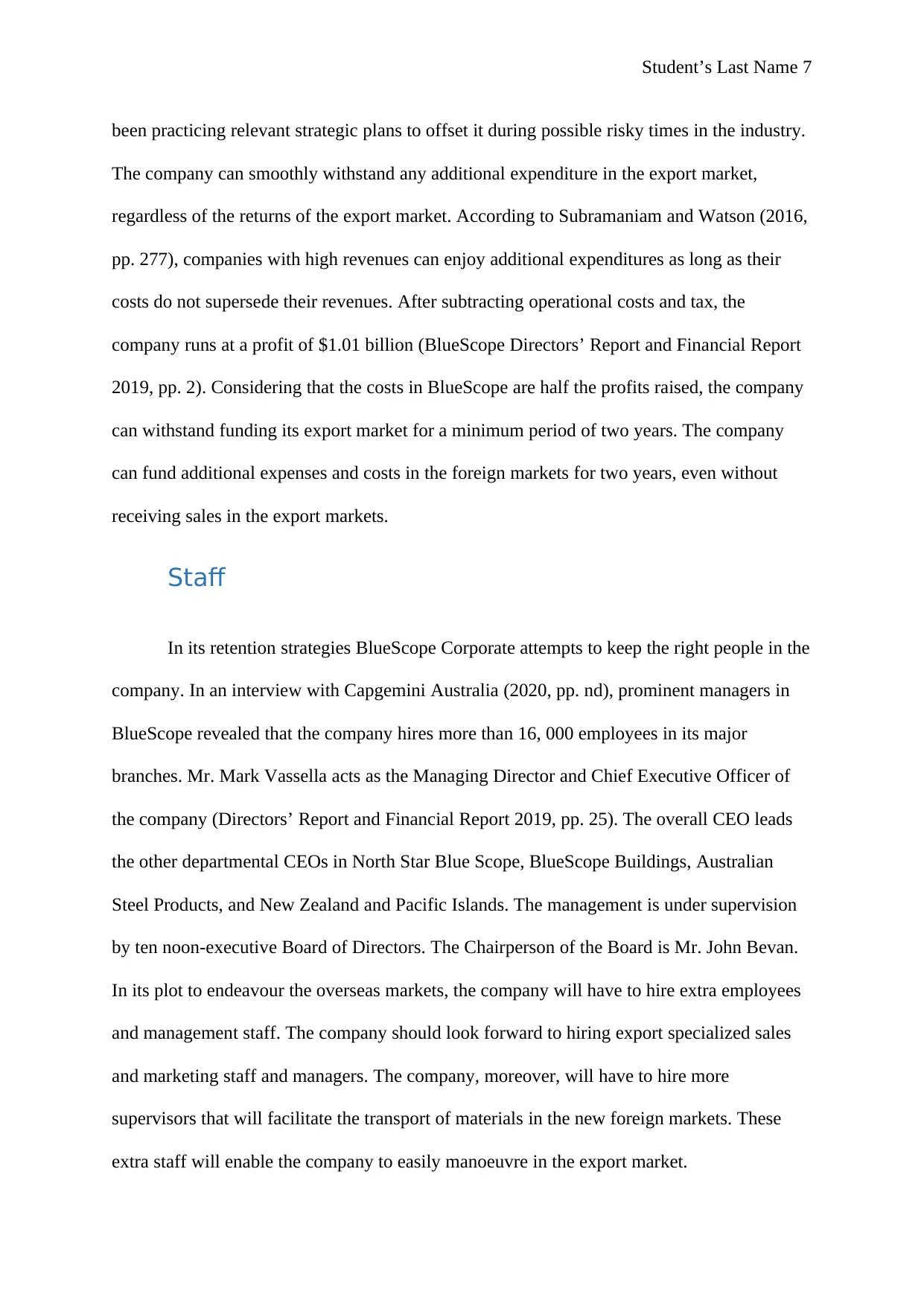
Student’s Last Name 7
been practicing relevant strategic plans to offset it during possible risky times in the industry.
The company can smoothly withstand any additional expenditure in the export market,
regardless of the returns of the export market. According to Subramaniam and Watson (2016,
pp. 277), companies with high revenues can enjoy additional expenditures as long as their
costs do not supersede their revenues. After subtracting operational costs and tax, the
company runs at a profit of $1.01 billion (BlueScope Directors’ Report and Financial Report
2019, pp. 2). Considering that the costs in BlueScope are half the profits raised, the company
can withstand funding its export market for a minimum period of two years. The company
can fund additional expenses and costs in the foreign markets for two years, even without
receiving sales in the export markets.
Staff
In its retention strategies BlueScope Corporate attempts to keep the right people in the
company. In an interview with Capgemini Australia (2020, pp. nd), prominent managers in
BlueScope revealed that the company hires more than 16, 000 employees in its major
branches. Mr. Mark Vassella acts as the Managing Director and Chief Executive Officer of
the company (Directors’ Report and Financial Report 2019, pp. 25). The overall CEO leads
the other departmental CEOs in North Star Blue Scope, BlueScope Buildings, Australian
Steel Products, and New Zealand and Pacific Islands. The management is under supervision
by ten noon-executive Board of Directors. The Chairperson of the Board is Mr. John Bevan.
In its plot to endeavour the overseas markets, the company will have to hire extra employees
and management staff. The company should look forward to hiring export specialized sales
and marketing staff and managers. The company, moreover, will have to hire more
supervisors that will facilitate the transport of materials in the new foreign markets. These
extra staff will enable the company to easily manoeuvre in the export market.
been practicing relevant strategic plans to offset it during possible risky times in the industry.
The company can smoothly withstand any additional expenditure in the export market,
regardless of the returns of the export market. According to Subramaniam and Watson (2016,
pp. 277), companies with high revenues can enjoy additional expenditures as long as their
costs do not supersede their revenues. After subtracting operational costs and tax, the
company runs at a profit of $1.01 billion (BlueScope Directors’ Report and Financial Report
2019, pp. 2). Considering that the costs in BlueScope are half the profits raised, the company
can withstand funding its export market for a minimum period of two years. The company
can fund additional expenses and costs in the foreign markets for two years, even without
receiving sales in the export markets.
Staff
In its retention strategies BlueScope Corporate attempts to keep the right people in the
company. In an interview with Capgemini Australia (2020, pp. nd), prominent managers in
BlueScope revealed that the company hires more than 16, 000 employees in its major
branches. Mr. Mark Vassella acts as the Managing Director and Chief Executive Officer of
the company (Directors’ Report and Financial Report 2019, pp. 25). The overall CEO leads
the other departmental CEOs in North Star Blue Scope, BlueScope Buildings, Australian
Steel Products, and New Zealand and Pacific Islands. The management is under supervision
by ten noon-executive Board of Directors. The Chairperson of the Board is Mr. John Bevan.
In its plot to endeavour the overseas markets, the company will have to hire extra employees
and management staff. The company should look forward to hiring export specialized sales
and marketing staff and managers. The company, moreover, will have to hire more
supervisors that will facilitate the transport of materials in the new foreign markets. These
extra staff will enable the company to easily manoeuvre in the export market.
Paraphrase This Document
Need a fresh take? Get an instant paraphrase of this document with our AI Paraphraser
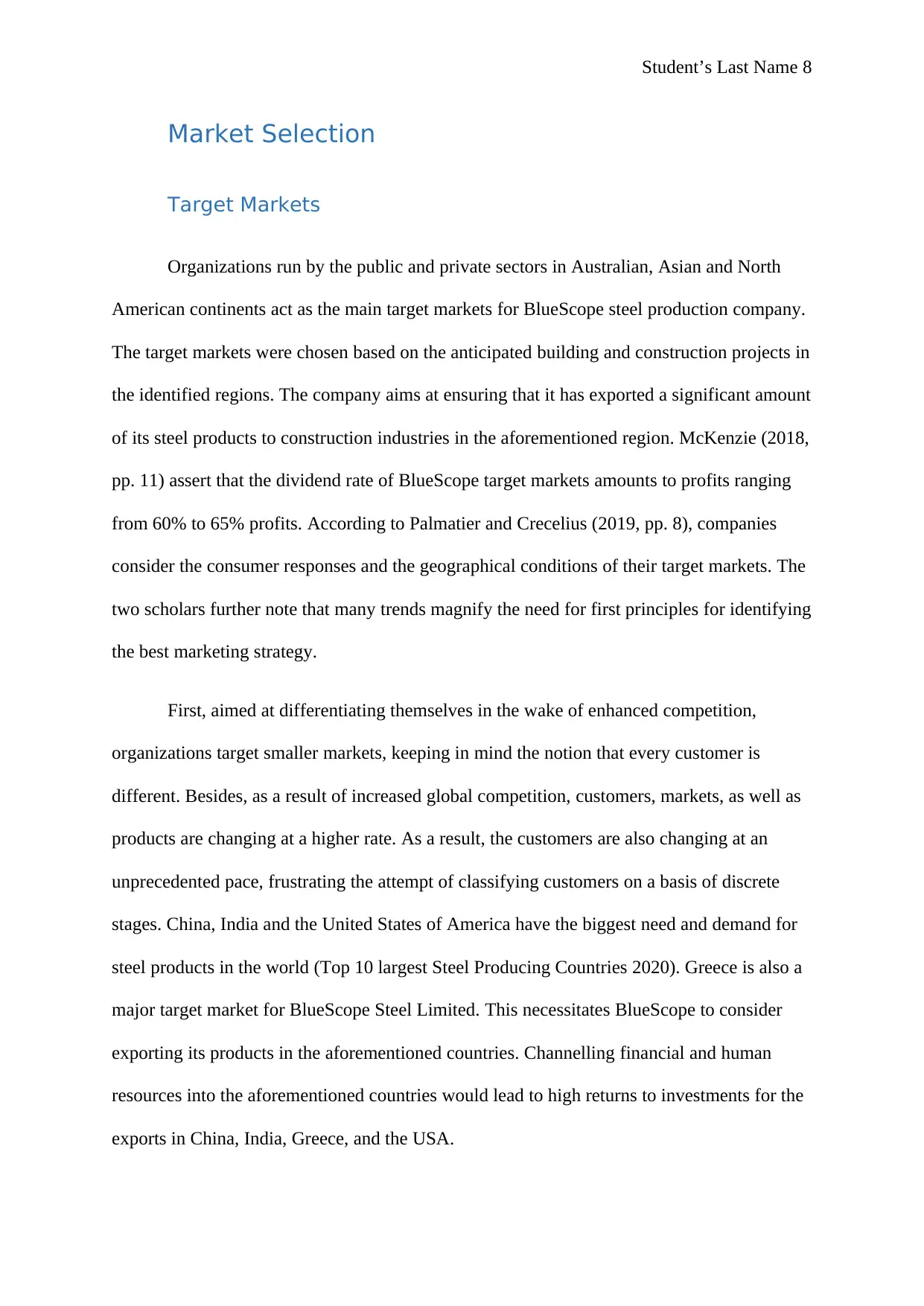
Student’s Last Name 8
Market Selection
Target Markets
Organizations run by the public and private sectors in Australian, Asian and North
American continents act as the main target markets for BlueScope steel production company.
The target markets were chosen based on the anticipated building and construction projects in
the identified regions. The company aims at ensuring that it has exported a significant amount
of its steel products to construction industries in the aforementioned region. McKenzie (2018,
pp. 11) assert that the dividend rate of BlueScope target markets amounts to profits ranging
from 60% to 65% profits. According to Palmatier and Crecelius (2019, pp. 8), companies
consider the consumer responses and the geographical conditions of their target markets. The
two scholars further note that many trends magnify the need for first principles for identifying
the best marketing strategy.
First, aimed at differentiating themselves in the wake of enhanced competition,
organizations target smaller markets, keeping in mind the notion that every customer is
different. Besides, as a result of increased global competition, customers, markets, as well as
products are changing at a higher rate. As a result, the customers are also changing at an
unprecedented pace, frustrating the attempt of classifying customers on a basis of discrete
stages. China, India and the United States of America have the biggest need and demand for
steel products in the world (Top 10 largest Steel Producing Countries 2020). Greece is also a
major target market for BlueScope Steel Limited. This necessitates BlueScope to consider
exporting its products in the aforementioned countries. Channelling financial and human
resources into the aforementioned countries would lead to high returns to investments for the
exports in China, India, Greece, and the USA.
Market Selection
Target Markets
Organizations run by the public and private sectors in Australian, Asian and North
American continents act as the main target markets for BlueScope steel production company.
The target markets were chosen based on the anticipated building and construction projects in
the identified regions. The company aims at ensuring that it has exported a significant amount
of its steel products to construction industries in the aforementioned region. McKenzie (2018,
pp. 11) assert that the dividend rate of BlueScope target markets amounts to profits ranging
from 60% to 65% profits. According to Palmatier and Crecelius (2019, pp. 8), companies
consider the consumer responses and the geographical conditions of their target markets. The
two scholars further note that many trends magnify the need for first principles for identifying
the best marketing strategy.
First, aimed at differentiating themselves in the wake of enhanced competition,
organizations target smaller markets, keeping in mind the notion that every customer is
different. Besides, as a result of increased global competition, customers, markets, as well as
products are changing at a higher rate. As a result, the customers are also changing at an
unprecedented pace, frustrating the attempt of classifying customers on a basis of discrete
stages. China, India and the United States of America have the biggest need and demand for
steel products in the world (Top 10 largest Steel Producing Countries 2020). Greece is also a
major target market for BlueScope Steel Limited. This necessitates BlueScope to consider
exporting its products in the aforementioned countries. Channelling financial and human
resources into the aforementioned countries would lead to high returns to investments for the
exports in China, India, Greece, and the USA.
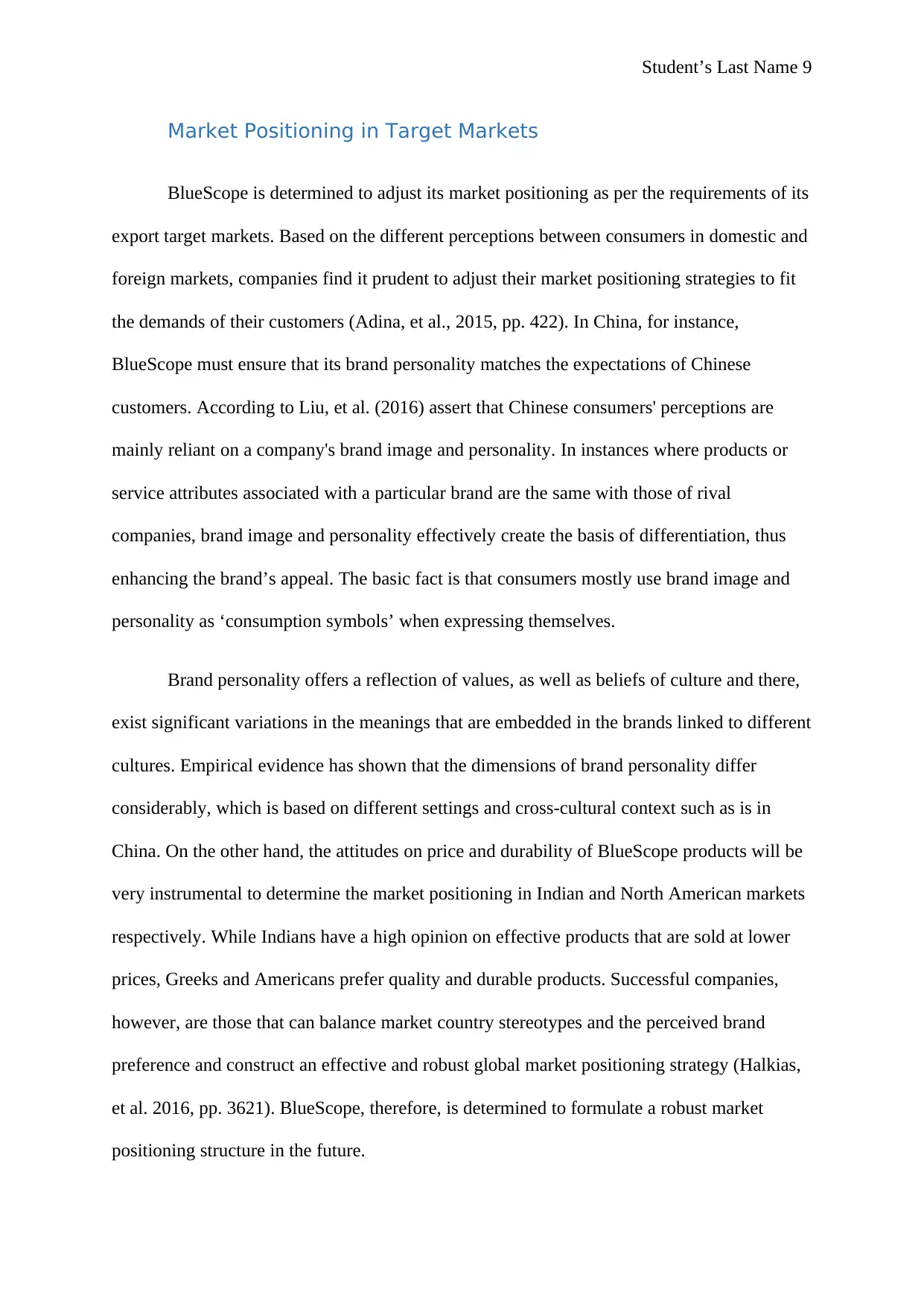
Student’s Last Name 9
Market Positioning in Target Markets
BlueScope is determined to adjust its market positioning as per the requirements of its
export target markets. Based on the different perceptions between consumers in domestic and
foreign markets, companies find it prudent to adjust their market positioning strategies to fit
the demands of their customers (Adina, et al., 2015, pp. 422). In China, for instance,
BlueScope must ensure that its brand personality matches the expectations of Chinese
customers. According to Liu, et al. (2016) assert that Chinese consumers' perceptions are
mainly reliant on a company's brand image and personality. In instances where products or
service attributes associated with a particular brand are the same with those of rival
companies, brand image and personality effectively create the basis of differentiation, thus
enhancing the brand’s appeal. The basic fact is that consumers mostly use brand image and
personality as ‘consumption symbols’ when expressing themselves.
Brand personality offers a reflection of values, as well as beliefs of culture and there,
exist significant variations in the meanings that are embedded in the brands linked to different
cultures. Empirical evidence has shown that the dimensions of brand personality differ
considerably, which is based on different settings and cross-cultural context such as is in
China. On the other hand, the attitudes on price and durability of BlueScope products will be
very instrumental to determine the market positioning in Indian and North American markets
respectively. While Indians have a high opinion on effective products that are sold at lower
prices, Greeks and Americans prefer quality and durable products. Successful companies,
however, are those that can balance market country stereotypes and the perceived brand
preference and construct an effective and robust global market positioning strategy (Halkias,
et al. 2016, pp. 3621). BlueScope, therefore, is determined to formulate a robust market
positioning structure in the future.
Market Positioning in Target Markets
BlueScope is determined to adjust its market positioning as per the requirements of its
export target markets. Based on the different perceptions between consumers in domestic and
foreign markets, companies find it prudent to adjust their market positioning strategies to fit
the demands of their customers (Adina, et al., 2015, pp. 422). In China, for instance,
BlueScope must ensure that its brand personality matches the expectations of Chinese
customers. According to Liu, et al. (2016) assert that Chinese consumers' perceptions are
mainly reliant on a company's brand image and personality. In instances where products or
service attributes associated with a particular brand are the same with those of rival
companies, brand image and personality effectively create the basis of differentiation, thus
enhancing the brand’s appeal. The basic fact is that consumers mostly use brand image and
personality as ‘consumption symbols’ when expressing themselves.
Brand personality offers a reflection of values, as well as beliefs of culture and there,
exist significant variations in the meanings that are embedded in the brands linked to different
cultures. Empirical evidence has shown that the dimensions of brand personality differ
considerably, which is based on different settings and cross-cultural context such as is in
China. On the other hand, the attitudes on price and durability of BlueScope products will be
very instrumental to determine the market positioning in Indian and North American markets
respectively. While Indians have a high opinion on effective products that are sold at lower
prices, Greeks and Americans prefer quality and durable products. Successful companies,
however, are those that can balance market country stereotypes and the perceived brand
preference and construct an effective and robust global market positioning strategy (Halkias,
et al. 2016, pp. 3621). BlueScope, therefore, is determined to formulate a robust market
positioning structure in the future.
⊘ This is a preview!⊘
Do you want full access?
Subscribe today to unlock all pages.

Trusted by 1+ million students worldwide
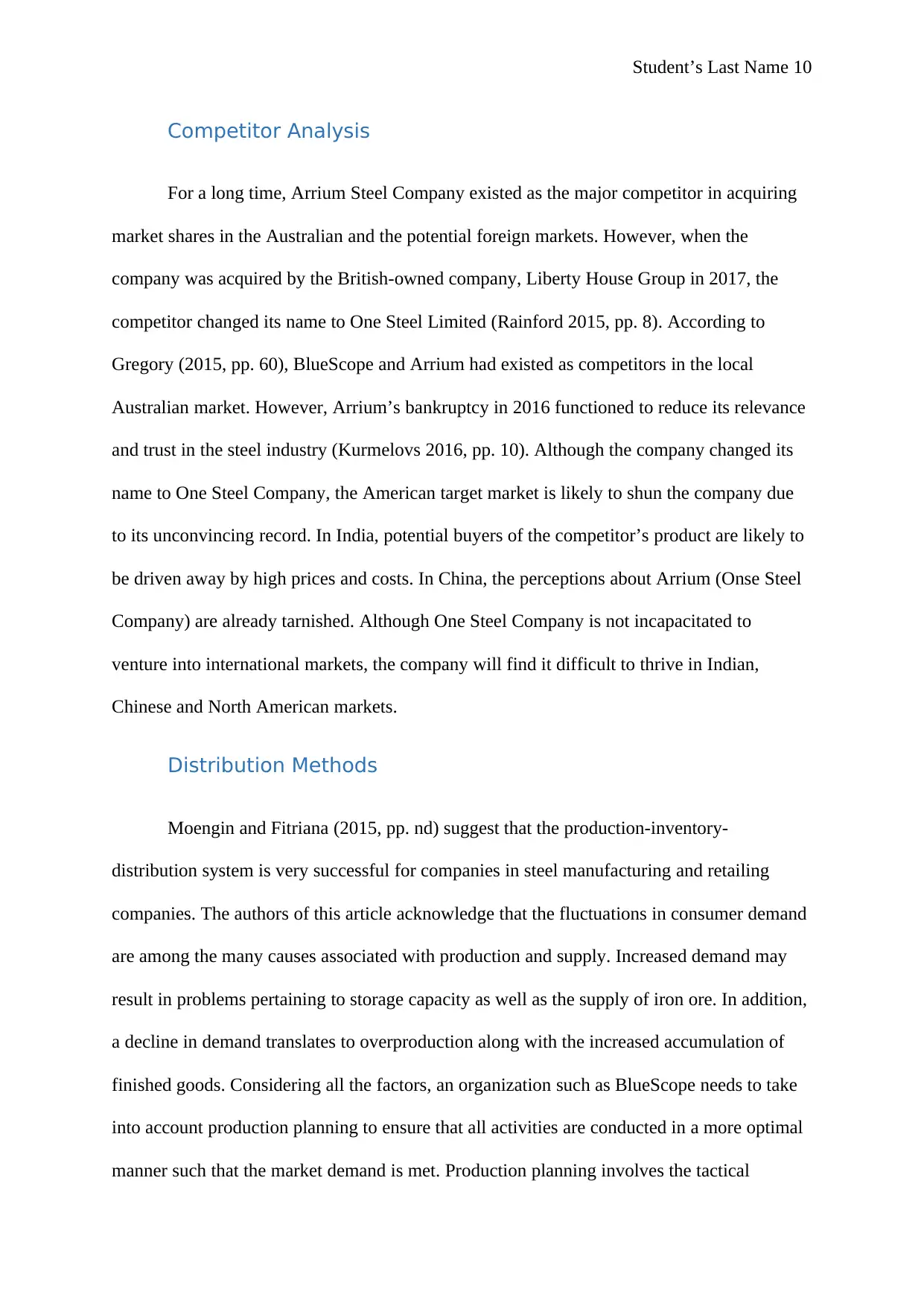
Student’s Last Name 10
Competitor Analysis
For a long time, Arrium Steel Company existed as the major competitor in acquiring
market shares in the Australian and the potential foreign markets. However, when the
company was acquired by the British-owned company, Liberty House Group in 2017, the
competitor changed its name to One Steel Limited (Rainford 2015, pp. 8). According to
Gregory (2015, pp. 60), BlueScope and Arrium had existed as competitors in the local
Australian market. However, Arrium’s bankruptcy in 2016 functioned to reduce its relevance
and trust in the steel industry (Kurmelovs 2016, pp. 10). Although the company changed its
name to One Steel Company, the American target market is likely to shun the company due
to its unconvincing record. In India, potential buyers of the competitor’s product are likely to
be driven away by high prices and costs. In China, the perceptions about Arrium (Onse Steel
Company) are already tarnished. Although One Steel Company is not incapacitated to
venture into international markets, the company will find it difficult to thrive in Indian,
Chinese and North American markets.
Distribution Methods
Moengin and Fitriana (2015, pp. nd) suggest that the production-inventory-
distribution system is very successful for companies in steel manufacturing and retailing
companies. The authors of this article acknowledge that the fluctuations in consumer demand
are among the many causes associated with production and supply. Increased demand may
result in problems pertaining to storage capacity as well as the supply of iron ore. In addition,
a decline in demand translates to overproduction along with the increased accumulation of
finished goods. Considering all the factors, an organization such as BlueScope needs to take
into account production planning to ensure that all activities are conducted in a more optimal
manner such that the market demand is met. Production planning involves the tactical
Competitor Analysis
For a long time, Arrium Steel Company existed as the major competitor in acquiring
market shares in the Australian and the potential foreign markets. However, when the
company was acquired by the British-owned company, Liberty House Group in 2017, the
competitor changed its name to One Steel Limited (Rainford 2015, pp. 8). According to
Gregory (2015, pp. 60), BlueScope and Arrium had existed as competitors in the local
Australian market. However, Arrium’s bankruptcy in 2016 functioned to reduce its relevance
and trust in the steel industry (Kurmelovs 2016, pp. 10). Although the company changed its
name to One Steel Company, the American target market is likely to shun the company due
to its unconvincing record. In India, potential buyers of the competitor’s product are likely to
be driven away by high prices and costs. In China, the perceptions about Arrium (Onse Steel
Company) are already tarnished. Although One Steel Company is not incapacitated to
venture into international markets, the company will find it difficult to thrive in Indian,
Chinese and North American markets.
Distribution Methods
Moengin and Fitriana (2015, pp. nd) suggest that the production-inventory-
distribution system is very successful for companies in steel manufacturing and retailing
companies. The authors of this article acknowledge that the fluctuations in consumer demand
are among the many causes associated with production and supply. Increased demand may
result in problems pertaining to storage capacity as well as the supply of iron ore. In addition,
a decline in demand translates to overproduction along with the increased accumulation of
finished goods. Considering all the factors, an organization such as BlueScope needs to take
into account production planning to ensure that all activities are conducted in a more optimal
manner such that the market demand is met. Production planning involves the tactical
Paraphrase This Document
Need a fresh take? Get an instant paraphrase of this document with our AI Paraphraser
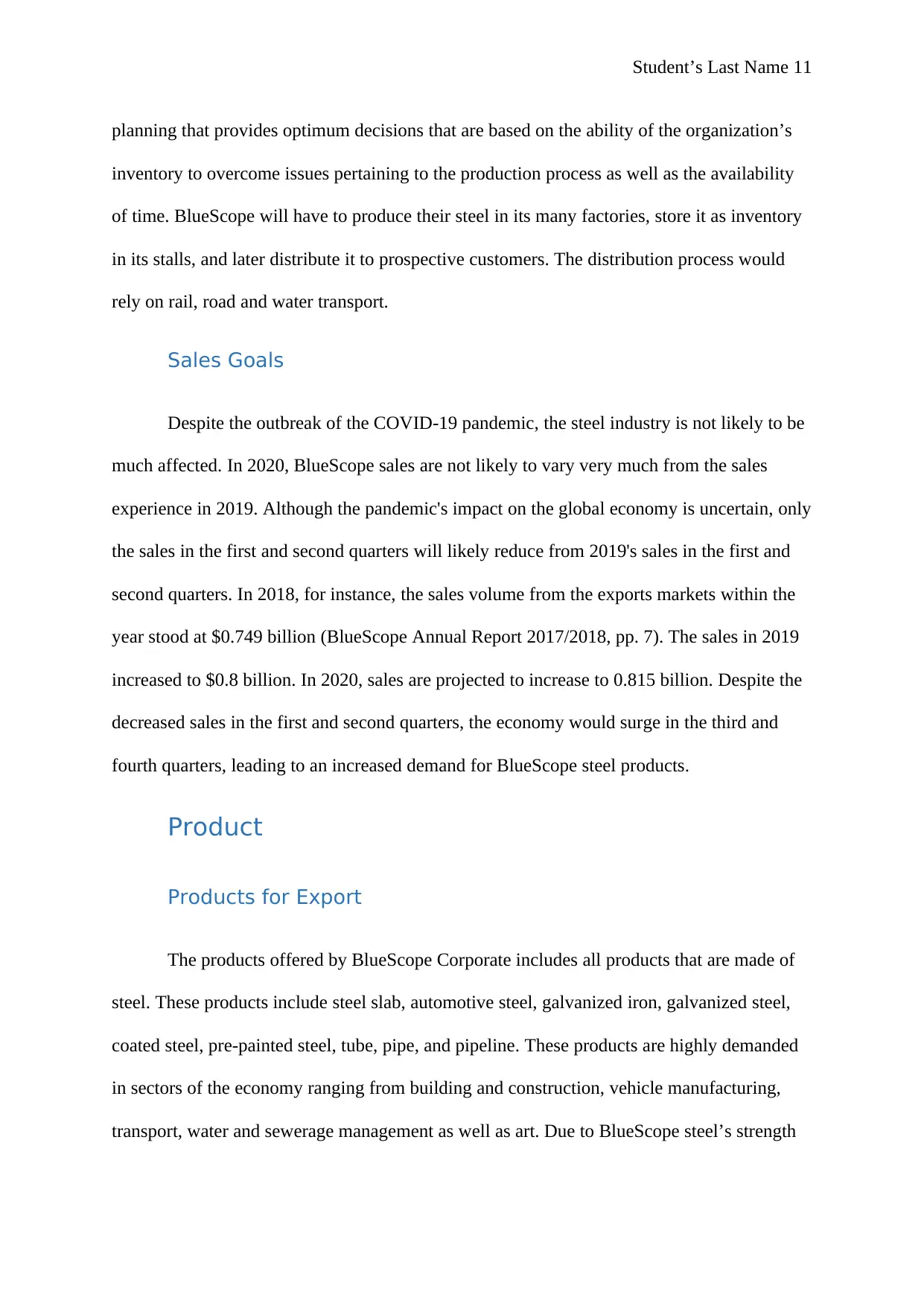
Student’s Last Name 11
planning that provides optimum decisions that are based on the ability of the organization’s
inventory to overcome issues pertaining to the production process as well as the availability
of time. BlueScope will have to produce their steel in its many factories, store it as inventory
in its stalls, and later distribute it to prospective customers. The distribution process would
rely on rail, road and water transport.
Sales Goals
Despite the outbreak of the COVID-19 pandemic, the steel industry is not likely to be
much affected. In 2020, BlueScope sales are not likely to vary very much from the sales
experience in 2019. Although the pandemic's impact on the global economy is uncertain, only
the sales in the first and second quarters will likely reduce from 2019's sales in the first and
second quarters. In 2018, for instance, the sales volume from the exports markets within the
year stood at $0.749 billion (BlueScope Annual Report 2017/2018, pp. 7). The sales in 2019
increased to $0.8 billion. In 2020, sales are projected to increase to 0.815 billion. Despite the
decreased sales in the first and second quarters, the economy would surge in the third and
fourth quarters, leading to an increased demand for BlueScope steel products.
Product
Products for Export
The products offered by BlueScope Corporate includes all products that are made of
steel. These products include steel slab, automotive steel, galvanized iron, galvanized steel,
coated steel, pre-painted steel, tube, pipe, and pipeline. These products are highly demanded
in sectors of the economy ranging from building and construction, vehicle manufacturing,
transport, water and sewerage management as well as art. Due to BlueScope steel’s strength
planning that provides optimum decisions that are based on the ability of the organization’s
inventory to overcome issues pertaining to the production process as well as the availability
of time. BlueScope will have to produce their steel in its many factories, store it as inventory
in its stalls, and later distribute it to prospective customers. The distribution process would
rely on rail, road and water transport.
Sales Goals
Despite the outbreak of the COVID-19 pandemic, the steel industry is not likely to be
much affected. In 2020, BlueScope sales are not likely to vary very much from the sales
experience in 2019. Although the pandemic's impact on the global economy is uncertain, only
the sales in the first and second quarters will likely reduce from 2019's sales in the first and
second quarters. In 2018, for instance, the sales volume from the exports markets within the
year stood at $0.749 billion (BlueScope Annual Report 2017/2018, pp. 7). The sales in 2019
increased to $0.8 billion. In 2020, sales are projected to increase to 0.815 billion. Despite the
decreased sales in the first and second quarters, the economy would surge in the third and
fourth quarters, leading to an increased demand for BlueScope steel products.
Product
Products for Export
The products offered by BlueScope Corporate includes all products that are made of
steel. These products include steel slab, automotive steel, galvanized iron, galvanized steel,
coated steel, pre-painted steel, tube, pipe, and pipeline. These products are highly demanded
in sectors of the economy ranging from building and construction, vehicle manufacturing,
transport, water and sewerage management as well as art. Due to BlueScope steel’s strength
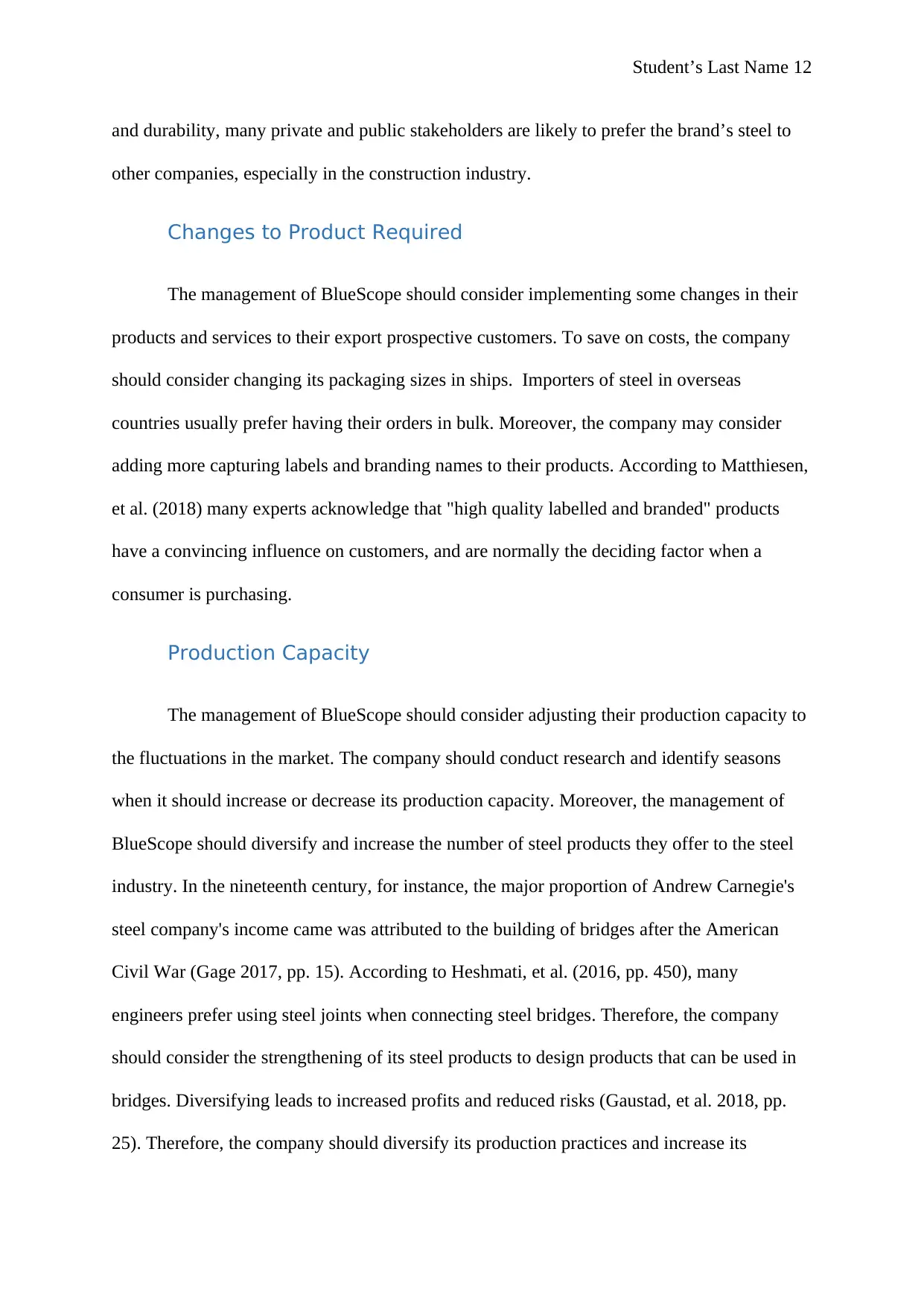
Student’s Last Name 12
and durability, many private and public stakeholders are likely to prefer the brand’s steel to
other companies, especially in the construction industry.
Changes to Product Required
The management of BlueScope should consider implementing some changes in their
products and services to their export prospective customers. To save on costs, the company
should consider changing its packaging sizes in ships. Importers of steel in overseas
countries usually prefer having their orders in bulk. Moreover, the company may consider
adding more capturing labels and branding names to their products. According to Matthiesen,
et al. (2018) many experts acknowledge that "high quality labelled and branded" products
have a convincing influence on customers, and are normally the deciding factor when a
consumer is purchasing.
Production Capacity
The management of BlueScope should consider adjusting their production capacity to
the fluctuations in the market. The company should conduct research and identify seasons
when it should increase or decrease its production capacity. Moreover, the management of
BlueScope should diversify and increase the number of steel products they offer to the steel
industry. In the nineteenth century, for instance, the major proportion of Andrew Carnegie's
steel company's income came was attributed to the building of bridges after the American
Civil War (Gage 2017, pp. 15). According to Heshmati, et al. (2016, pp. 450), many
engineers prefer using steel joints when connecting steel bridges. Therefore, the company
should consider the strengthening of its steel products to design products that can be used in
bridges. Diversifying leads to increased profits and reduced risks (Gaustad, et al. 2018, pp.
25). Therefore, the company should diversify its production practices and increase its
and durability, many private and public stakeholders are likely to prefer the brand’s steel to
other companies, especially in the construction industry.
Changes to Product Required
The management of BlueScope should consider implementing some changes in their
products and services to their export prospective customers. To save on costs, the company
should consider changing its packaging sizes in ships. Importers of steel in overseas
countries usually prefer having their orders in bulk. Moreover, the company may consider
adding more capturing labels and branding names to their products. According to Matthiesen,
et al. (2018) many experts acknowledge that "high quality labelled and branded" products
have a convincing influence on customers, and are normally the deciding factor when a
consumer is purchasing.
Production Capacity
The management of BlueScope should consider adjusting their production capacity to
the fluctuations in the market. The company should conduct research and identify seasons
when it should increase or decrease its production capacity. Moreover, the management of
BlueScope should diversify and increase the number of steel products they offer to the steel
industry. In the nineteenth century, for instance, the major proportion of Andrew Carnegie's
steel company's income came was attributed to the building of bridges after the American
Civil War (Gage 2017, pp. 15). According to Heshmati, et al. (2016, pp. 450), many
engineers prefer using steel joints when connecting steel bridges. Therefore, the company
should consider the strengthening of its steel products to design products that can be used in
bridges. Diversifying leads to increased profits and reduced risks (Gaustad, et al. 2018, pp.
25). Therefore, the company should diversify its production practices and increase its
⊘ This is a preview!⊘
Do you want full access?
Subscribe today to unlock all pages.

Trusted by 1+ million students worldwide
1 out of 18
Related Documents
Your All-in-One AI-Powered Toolkit for Academic Success.
+13062052269
info@desklib.com
Available 24*7 on WhatsApp / Email
![[object Object]](/_next/static/media/star-bottom.7253800d.svg)
Unlock your academic potential
Copyright © 2020–2025 A2Z Services. All Rights Reserved. Developed and managed by ZUCOL.




